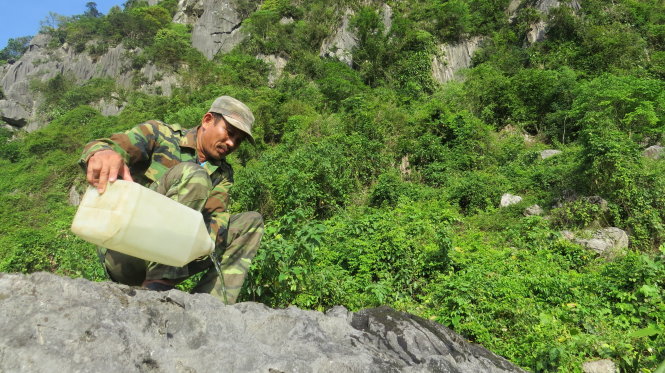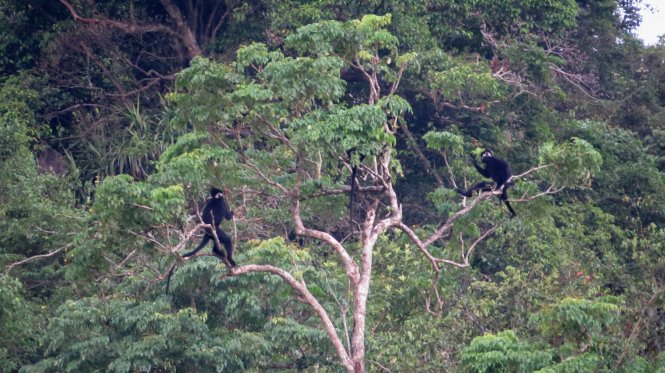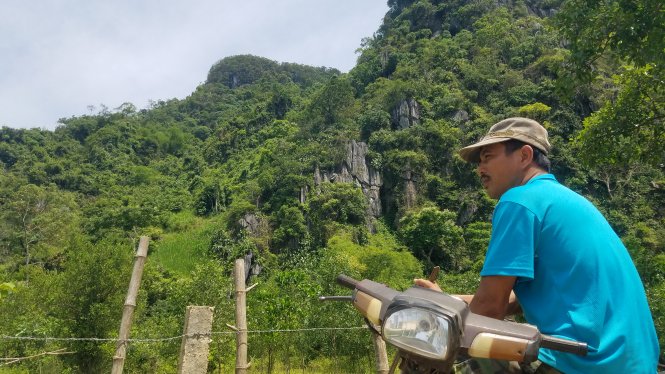A man from central Vietnam has enthusiastically safeguarded threatened monkeys for around five years after giving up his job as a hunter in the wake of a poignant experience that left an indelible mark in his mind.
In the midday sun of a recent day, Nguyen Van Hong was speeding on a ramshackle motorcycle from his home to a nearby cliff in Tuyen Hoa District, Quang Binh Province.
“Don’t kill langurs,” the man in his 50s cried while riding the vehicle.
The shout prompted three young men to hastily hide their self-built rifles in a bag, dash into a waiting seven-seater car and run away.
“It’s lucky that I showed up at the right time, otherwise some langurs would have been killed,” Hong said.
This was not the first time Hong had stopped a meal midway to shoo those attempting to shoot Hatinh langurs, a highly endangered leaf-eating monkeys endemic to Vietnam with a thin white line of fur over the upper lip that stretches from the mouth to the cheeks, ears and neck.
He has done the unpaid job over the past five years, and some residents in Quang Binh said he cared more about the primates than about himself.
Following Hong’s protective efforts, some langurs have had the courage to move their usual feeding ground from the top of a cliff down to the foliage near his village.
But the mammals’ proximity to humans worries Hong, who now finds it necessary to ride his motorbike more frequently around the cliff foot in order to preempt any illegal hunting as people with guns usually try to ascend the area of rock when he is away.
To have surveillance spread throughout the day, Hong asks local residents to call him whenever they catch sight of suspected hunters.
“Because of his enthusiasm, villagers always try their best to help him,” one of Hong’s neighbors said.
 |
| Nguyen Van Hong pours water into a stone hollow for langurs to drink in Quang Binh Province, Vietnam. Photo: Tuoi Tre |
Hong said in the dry season, when water is scarce even for wild animals, he has to provide langurs with water by pouring it into a hollow in a large stone while producing a langur-like sound with his mouth to attract the animals’ attention.
Hunter-turned-protector
Hong’s devotion to langurs began in days when killing animals was his livelihood.
The man was a very skilled hunter for nearly 20 years, taking the lives of various creatures, including langurs, which in the past locals perceived simply as monkeys that needed no protection, Hong recalled.
“There were days when I caught up to several langurs,” Hong recollected.
But one day he found two monkeys at a time, one of them a female langur stuck in a trap he set up.
“Is it possible that a trap can catch two langurs?” he wondered.
Approaching them, he realized that the female langur was already dead but the live male one was hugging her with sad eyes, he said.
The sight, he continued, rendered him disenchanted with hunting.
As a result, Hong found no motivation in laying traps in the forest anymore even though his family was poor and he received orders for jungle animals from customers.
In 2013, he completely gave up the job on the strength of an acquaintance who told him that the local langurs belong to an endangered species.
He has since used his rich hunting experience to remove traps set by others.
 |
| Hatinh langurs are perched on a tree in Quang Binh Province, Vietnam. Photo: Tuoi Tre |
Pham Hong Thai, an official from the Forest Protection Department in Quang Binh, said thanks to Hong’s protection, the langur population of a local area has increased to 100 from 30 several years earlier.
“There’re no ways to express our happiness about the improvement. People like Hong have brought the langurs from the brink of extinction. We’re grateful to him,” Thai said.
Hatinh langurs received their scientific name of trachypithecus hatinhensis in 1970, and were discovered at the province’s Phong Nha-Ke Bang National Park, which is a UNESCO World Heritage Site, 25 years later.
Their first reported sighting in Dong Hoa District, where Hong lives, came in 2015.
The severe decline in the number of Hatinh langurs prior to 2010 due to excessive hunting came to a halt when Hong began trying to keep them from harm.
The hunter-turned-guardian earned official recognition for his wildlife protection effort.
Like us on Facebook or follow us on Twitter to get the latest news about Vietnam!



















































